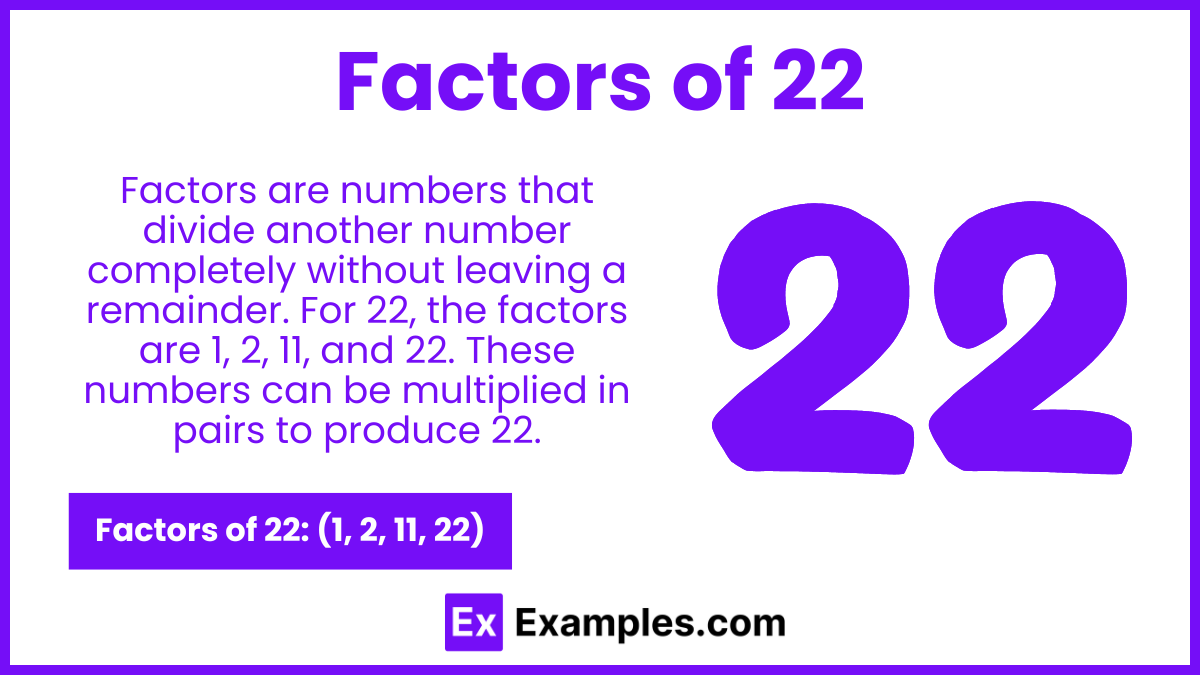What are the factors of 22?
1, 2, 3, 6, 11, 22
1, 2, 11, 22
1, 2, 4, 11, 22
1, 3, 7, 22

The factors of 22 can enhance your grasp of basic arithmetic and number theory. Factors are numbers that divide a given number without leaving a remainder. For 22, identifying these factors involves finding all possible pairs of numbers that, when multiplied, equal 22. This knowledge is essential for simplifying fractions, solving mathematical problems, and understanding the properties of numbers. In this article, we will explore the factors of 22, including its prime factorization, pair factors, and the methods to determine these factors accurately and efficiently. Join us as we delve into the fascinating world of numbers.

The factors of 22 are 1, 2, 11, and 22. These numbers can divide 22 without leaving a remainder. For instance, multiplying 2 by 11 gives 22. Understanding these factors is important for simplifying fractions, finding common denominators, and solving mathematical equations. The prime factorization of 22 is 2 and 11, highlighting its basic prime components. Recognizing these factors helps in various arithmetic and algebraic applications, making calculations more efficient.
Determining the prime factors of 22 involves breaking it down into its fundamental prime components. This process reveals the prime numbers that, when multiplied together, equal 22.
Begin with the smallest prime number, which is 2. Check if 22 is divisible by 2. Since 22 is an even number, it can be divided by 2.
Divide 22 by 2, resulting in 11. Therefore, 22 can be written as 2 times 11.
Verify if the remaining factor, 11, is a prime number. Since 11 has no divisors other than 1 and itself, it is indeed a prime number.
List the identified prime factors. The prime factors of 22 are 2 and 11.
To find all factors of 22, you need to determine the numbers that divide 22 without leaving a remainder.
So, the factors of 22 are 1, 2, 11, and 22.
Prime factorization involves breaking down 22 into its prime components.
Thus, the prime factorization of 22 is 2×112×11.
Determine the factor pairs of 22. Factor pairs are two numbers that, when multiplied, give the product 22.
Therefore, the factor pairs of 22 are (1, 22) and (2, 11).
Simplify the fraction 22/44 using common factors. Find the greatest common factor (GCF) of 22 and 44.
Divide the numerator and the denominator by their GCF:
22÷22/44÷22=1/2
So, 22/44 simplifies to 1/2.
Identify common factors of 22 and another number, say 33.
Therefore, the common factors of 22 and 33 are 1 and 11.
Understanding the factors of 22 is essential for various mathematical operations and problem-solving. Here are some tips to help you identify and work with these factors effectively:
The prime factorization of 22 is 2×112×11. Both 2 and 11 are prime numbers.
The least common multiple of 22 and another number is found by identifying the smallest multiple that both numbers share. For instance, the LCM of 22 and 33 is 66.
The positive pair factors of 22 are (1, 22) and (2, 11). The negative pair factors are (-1, -22) and (-2, -11). These pairs multiply together to give 22, either as positive or negative products.
To find the factors of 22 by division, divide 22 by each integer from 1 to 22. If the division results in an integer without a remainder, then the divisor is a factor. The factors of 22 found this way are 1, 2, 11, and 22.
The sum of all the factors of 22 is calculated by adding 1, 2, 11, and 22. So, the sum is 1+2+11+22=36. Thus, the total sum of the factors of 22 is 36.
The greatest common factor (GCF) of 22 and 13 is 1. This is because 13 is a prime number, and the only common divisor between 22 and 13 is 1, as 13 does not divide 22 evenly.
Text prompt
Add Tone
10 Examples of Public speaking
20 Examples of Gas lighting
What are the factors of 22?
1, 2, 3, 6, 11, 22
1, 2, 11, 22
1, 2, 4, 11, 22
1, 3, 7, 22
Which number is NOT a factor of 22?
2
5
7
11
If a number is a factor of 22, which of the following must be true?
It must be greater than 22.
It must be a prime number.
It must divide 22 exactly.
It must be less than 22.
Which pair of numbers multiplies to give 22?
2 and 11
1 and 22
3 and 7
2 and 10
What is the smallest factor of 22?
1
11
22
33
How many factors does 22 have?
3
4
5
6
Which of the following numbers is a multiple of a factor of 22?
13
24
30
44
If you subtract the smallest factor of 22 from the largest factor, what is the result?
20
21
22
23
Which factor of 22 is also a prime number?
1
2
11
22
What is the sum of all factors of 22?
22
28
34
28
Before you leave, take our quick quiz to enhance your learning!

